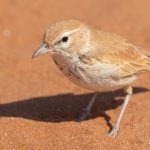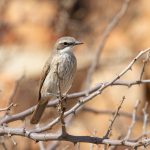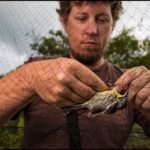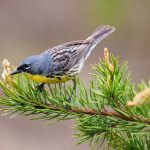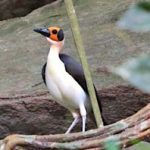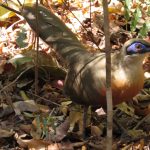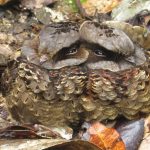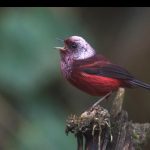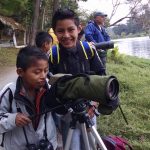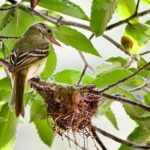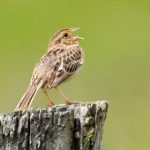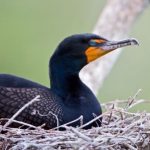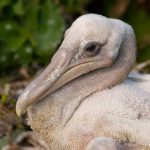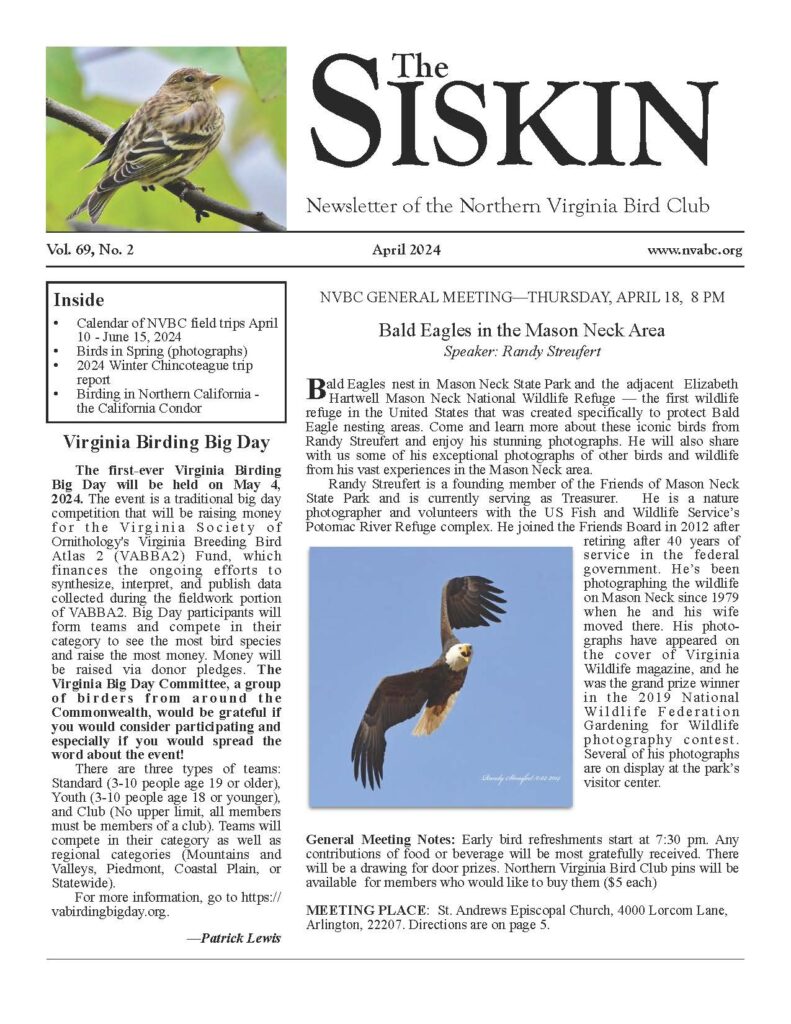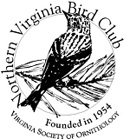Upcoming meeting-
April 18th, 8PM. Bald Eagles in the Mason Neck Area, Speaker: Randy Streufert Bald Eagles nest in Mason Neck State Park and the adjacent Elizabeth Hartwell Mason Neck National Wildlife Refuge — the first wildlife refuge in the United States that was created specifically to protect Bald Eagle nesting areas. Come and learn more about these iconic birds from Randy Streufert and enjoy his stunning photographs. He will also share with us some of his exceptional photographs of other birds and wildlife from his vast experiences in the Mason Neck area.
Randy Streufert is a founding member of the Friends of Mason Neck State Park and is currently serving as Treasurer. He is a nature photographer and volunteers with the US Fish and Wildlife Service’s Potomac River Refuge complex. He joined the Friends Board in 2012 after retiring after 40 years of service in the federal government. He’s been
photographing the wildlife on Mason Neck since 1979 when he and his wife moved there. His photographs have appeared on the cover of Virginia Wildlife magazine, and he
was the grand prize winner in the 2019 National Wildlife Federation Gardening for Wildlife photography contest. Several of his photographs are on display at the park’s
visitor center.
Early bird refreshments start at 7:30 pm. Any contributions of food or beverage will be most gratefully received. There will be a drawing for door prizes. Northern Virginia Bird Club pins will be available for members who would like to buy them ($5 each).
MEETING PLACE: St. Andrews Episcopal Church, 4000 Lorcom Lane,
Arlington, 22207.
Previous meetings-
From Zero to 9600 –A Life of Birding, Speaker: Peter Kaestner. Peter Kaestner is a retired American diplomat and fanatical birder who is now the leading eBirder in the world in terms of number of species observed (9,473 as of July 1, 2022). His career has taken him all over the world including posts in India, Egypt, Brazil, Guatemala, Papua New Guinea, the Solomon Islands, Colombia, Malaysia, Germany, Afghanistan, and Namibia. After retiring from the State Department in 2016, he now resides near Baltimore and leads bird tours with Rockjumper. He has seen at least one species of all 260 living families of birds, after becoming the first to achieve this feat in 1986 (when there were only 159 recognized families!). In 1989, while returning from a work visit to Villavicencio, Colombia, he discovered a species new to science, the Cundinamarca Antpitta (Grallaria kaestneri). He highlighted this experience in his 2nd presentation before the NVBC back in 2011. This presentation will be about recent birding and plans for the future, with some time allowed to take questions from the audience.
The Intelligence of Birds, Speaker: William Young. April 21, 2022, 8 PM.
How intelligent are birds? And how should avian intelligence be measured? During the past 20 years, scientists have discovered that birds are capable of much more complex thought processes than previously believed. Bill Young will examine many aspects of bird intelligence, including problem solving, memory, artistic talent, and the ability to be
devious.
Bill, who has made many previous presentations at NVBC meetings, is a writer who lives in Arlington. He now spends much of his time teaching Zoom classes. His 2022 presentations include a course about birds and language, workshops on how to identify warblers and waterfowl, and programs about the role of birds and nature in the cultures of both East Asia and Latin America. He is the co-creator (with Ashley Bradford) of the MPNature.com website, which contains a wealth of information about natural
history in Virginia and b e y o n d . His book The Fascination of Birds: From the Albatross to the Yellowthroat examines birds in the contexts of science,
history, language, culture, and other areas. He also makes
nature videos, and his YouTube channel (https://www.youtube.com/user/ williamyoung42) has had more than 850,000 views.
The April virtual meeting will be held using Zoom starting as early as 7:30 pm
with the featured speaker at 8pm. Please register in advance by clicking on the registration
link found at the upper right at the Northern Virginia Bird Club website (nvabc.org). Upon registering, an email automatically will be sent with a link to click on to join the meeting. There will be ample time to take questions from the audience.
Our Wonderful Wood Warblers
Speaker: Bob Schamerhorn
Bob Schamerhorn is a national award-winning nature photographer. His presentation shows the indisputable beauty and diversity of some of our most spectacular birds. Warblers are amongst our smallest, yet most brilliantly colored avian visitors. Most of these birds are only present in Virginia for brief periods, during their spring and fall migrations. Most of our native Virginia species are represented. Many warblers have entirely different plumage at different times of the year making them difficult to differentiate. Learn about identification of this diverse group of birds by sight, sound, season, and habitat. This multimedia presentation includes photographs, HD video clips and accompanying birdsong. It makes for a great identification course in preparation for spring migration.
Bob Schamerhorn has been fascinated with nature since his childhood in Lynchburg, Virginia. His beautiful web site, iPhotobirds.com, is a compilation of his nature photography and efforts as a nature enthusiast. It provides information about his presentations and products that are available to order.
The Wildlife of Uganda Speaker: William Young
Uganda is an East African country teeming with birds and other wildlife.
Popular local writer and naturalist William Young will talk about what
he saw on a trip to Uganda in 2016-17. He is the author of the book The
Fascination of Birds: From the Albatross to the Yellowthroat, and he is the
co-creator (with Ashley Bradford) of the MPNature.com website about the
birds and natural history of Monticello Park in Alexandria.
The November virtual meeting will be held using Zoom. The meeting
begins at 8 pm, and you can enter after 7:30 pm. Please register in advance
by clicking on the registration link found at the upper right at the Northern
Virginia Bird Club website (nvabc.org). Upon registering, an email
automatically will be sent with a link to join the meeting. There will be
ample time for questions from the audience.
Local Birding Adventures Around the Region Including Northern Virginia Parks, Speaker: Matt Felperin
Matt Felperin is a local naturalist and photographer who has been making the best of the limitations due to Covid-19. His latest newsworthy adventure involved rescuing a Common Loon that landed in a Fairfax pond from which it couldn’t take off. Recently he photographed a Wilson’s Phalarope in the Reflecting Pool. He is currently the Roving Naturalist for the Northern Virginia Parks. His photographs and tales of birding on foot and by kayak ought to be a light and fun presentation.
Colonial Waterbird Conservation In the Hampton Roads: Reflections on birds, bridges, politics, journalism and environmental activism. Speaker: Dr. Sarah Karpanty
Dr. Karpanty is a Professor of Fish and Wildlife Conservation at Virginia Tech. She will speak to us about the history of colonial waterbirds nesting on the South Island of the Hampton Roads Bridge tunnel, their temporary re-homing to Fort Wool/Rip-Rap Island and barges, and what the future may hold. She will also emphasize the important role that bird conservation groups played in the successful interim resolution and hopefully will play in the successful long-term resolution. She has also been studying shorebirds on the Eastern Shore barrier islands since 2005 so would be happy to talk about that as well and field any questions that arise!
The April virtual meeting will be held using Zoom. You can register for the free meeting here (click here). This information will be sent to the Club exchange email list and will be in this Siskin that is posted on our web site. There will be another person on the call who will take the questions from the audience. After the speaker has completed the presentation, his colleague will feed him the questions and Bill will respond to the questions and comments.
Bird Survival Adaptations in the Himalaya, Speaker: Dr. Sahas Barve.
Birds that live at high elevations have to deal with two major environmental challenges: the cold and the lack of oxygen. Dr. Barve will talk about how Himalayan birds have adjusted to cope with both these pressures during his virtual presentation.
Dr. Barve is an avian evolutionary ecologist and currently a Peter Buck Fellow at the Smithsonian National Museum of Natural History. He grew up in Mumbai, India and was always outside watching birds. He is an avid birder and hopes to see 6,000 bird species by the time he is 60. Dr. Barve has a beautiful image of the Trishul massif (about 23,500 feet) in the Himalaya of northern India on his homepage. You can learn more about his other avian research at sahasbarve.com.
White-Tailed Deer in Northern Virginia, Speaker: Bill Browning. Thursday, November 19, 2020.
Deer are a beautiful part of our landscape today and they provided an ample source of food for the early European settlers. In Virginia, we practically drove the deer population to extinction by the early twentieth century, though it has recovered since then and approaches nearly a million today. Indeed, the deer numbers are so high that they are endangering our forests. And our degraded forests are unable to provide good habitat for wildlife, including birds, or provide ecosystem services such as water absorption and filtration.
In this presentation, Bill Browning will talk about how this population cycle has occurred, and what it means for our parks, forests, and neighborhood. He’ll also talk about the implications for continuing to
ignore the increase in the number of deer, especially in Northern Virginia, and about how some of our neighboring jurisdictions have chosen to approach the problem.
Bill Browning has been a certified Virginia Master Naturalist (a Virginia Cooperative Extension program) since 2013, and completed the Audubon Naturalist Society Natural History Field Studies program in 2018. He is passionate about working to help rehabilitate our local forests and making them better habitats for native flora and fauna. In Powhatan Springs Park which is just east of Upton Hills Park off Wilson Boulevard in Arlington he has been working for several years to transform a neglected park that was overrun with invasive plants into a healthier natural habitat for birds. Over 40 species have been documented in the park over the last year. Bill is a retired intelligence officer and has extensive teaching
experience. He has lived in Arlington since 1988, and he and his wife have raised three children in the community.
Birding Four Corners of the Lower 48. Speaker: Larry Meade. The United States contains a rich variety of biomes and habitats. For a traveler interested in nature, this means that one can find in many
regions of the country a different mix of plants, birds, insects and animals. Larry Meade has traveled to each corner of the contiguous United States in search of birds and other fascinating experiences. He will share photos and stories from his trips to Maine, South Florida (two trips), Washington state, and San Diego County, California.
Larry Meade is the president of the Northern Virginia Bird Club and a former board member of the Virginia Society of Ornithology. He serves as sector leader for several Christmas Bird Counts and is an avid nature photographer. He often leads nature walks for the Club and other groups in our area and teaches workshops for the Audubon Society of Northern Virginia.
The September virtual meeting will be held using Zoom.which many of our members have used these last few months. If you are not familiar with Zoom you can visit this link for a brief introduction on doing a
Zoom meeting: https://support.zoom.us/hc/en-us/articles/201362193-How-Do-I-Join-A-Meeting. Each Zoom meeting has a unique number. This information will be sent to the Club exchange email list
(see Siskin back page on how to join) and will be in this Siskin that is posted on our website. If you join the Zoom meeting early, you can chat with others. During the speaker’s presentation, please mute your device
and turn off your video to reduce the noise and help the communication speed. There will be time afterwards to speak again and ask questions.
Birding Namibia and Northern Botswana. Speaker: Diane Marton. Photography by Josh Engel and Warren Marton. Birding Namibia and northern Botswana this past July with guide Josh Engel of Red Hill Birding turned out to be the “trip of a lifetime” for Diane and Warren Marton. Set amidst spectacular scenery—the world’s oldest desert and highest sand dunes, a long coastline and a lush riverine forest—is world class birding. Think numerous hornbill and bustard species, Rüppell’s Parrot, Rockrunner, Hartlaub’s Francolins, and the iconic bird of the Okavango, Pel’s Fishing Owl. Add in the palette in pink created by thousands of flamingoes and waterbirds at Walvis Bay. The uncommon Herero Chat, found only in the Namibia Escarpment and never easy to find,
popped up in a shrub two feet away from the road. Namibia’s only endemic bird, the Dune Lark, skittered around inches from Diane’s feet as she stood motionless in red sand dunes. What could be better? But of course there is the African game, the highlight of the trip actually being one of the smaller, the African Wild Cat hunting doves (unsuccessfully) at a waterhole in Etosha National Park.
Diane is a retired children’s librarian with Arlington County, VA. She is a longtime member of the Northern Virginia Bird Club. Rather than participating in local bird walks of late, she has been systematically removing English ivy and other invasives from her yard and replanting with native species. Warren is a retired project manager from the US Department of Energy, where he focused on fusion energy.
- Dune Lark, photo by Josh Engel.
- Herero Chat, photo by Josh Engel.
Kirtland’s Warbler Conservation and Research in the Bahamas and Michigan
Speaker: Nathan W. Cooper Join Nathan W. Cooper as he talks about the natural and conservation
history of the Kirtland’s Warbler. He will share his latest research on the species. Topics will include tracking Kirtland’s Warblers across their annual cycle and reducing the conservation reliance of Kirtland’s Warblers through adaptive management of the cowbird control program. Kirtland’s Warbler is
an endangered migratory songbird that breeds almost exclusively in Michigan. They winter primarily in the Bahamas. Despite a successful cowbird control program that began in 1971, the Kirtland’s Warbler
population count dropped to just 187 males in the wild in 1974. The Endangered Species Act led to state and federal agencies creating new Jack Pine habitat resulting in substantial recovery of the warbler population. More than 2,300 Kirtland’s Warbler males were counted in the last population census.
Nathan is interested in the behavioral ecology and conservation of migratory birds. He first joined the Smithsonian Migratory Bird Center as a Ph.D. student under Pete Marra in 2008 and earned his doctorate in ecology and evolutionary biology from Tulane University in 2014. He continued at the Center as a postdoctoral fellow focusing on the Kirtland’s Warbler.
- photo by Nathan Cooper
- Photo by Nathan Cooper
================================================================================
Ghana: West Africa’s great new birding destination. Speaker: Joanna Taylor
This past spring Mary Scala and Joanna Taylor visited Ghana, West Africa, a friendly, stable country, on a three-week birding tour managed by Field Guides. West Africa has lagged behind east and south Africa as a birding and tourist destination, but Ghana is one of the first countries in the area to embrace the idea of eco-tourism and the
infrastructure necessary to support it. The country has a lot to offer the birder. Ghana has both rain forest with a wonderful canopy walk and savannah and national parks and has over 750 species of birds, many of them endemic to west Africa. The star of the show is the White-necked Rockfowl, Picathartes gymnecephalus. Picathartes is a two species genus and very difficult to locate. A nesting colony is being carefully guarded by a nearby village and the birds are easy to see. There are also many species of Hornbills, Bee-eaters, Kingfishers and others to delight the eye.
Joanna Taylor is a longtime member of the NVBC and has been a member of the Board of the club for about 25 years. She is retired from the Department of State and lived next door to Ghana in Togo for two
years where she birded extensively. Both she and Mary Scala volunteer at the bird banding station at Occoquan NWR. Mary Scala was a Peace Corps volunteer in Ghana for three years and enjoyed seeing her old stomping ground.
- White-necked rock fowl
Madagascar’s Biodiversity: Vangas and Couas and Lemurs, Oh My! Speaker Libby Lyons. Join Libby Lyons as she describes how she joined her daughter, a lemur researcher, for two and a half weeks exploring the biodiversity of Madagascar in July 2018. Libby will share her photos to illustrate how the biodiversity differs across the island’s dry western tropical deciduous forests, mid- and low-altitude eastern rainforests, and the southern spinybush forests, with attention not only to birds, but also to plants, lemurs, tenrecs, chameleons, and those masters of camouflage, the leaf-tailed geckos. She will describe endemic groups of birds – couas, asities, mesites, tetrakas, and ground rollers – and her favorite, the vangas, a diverse family that challenges Darwin’s finches in the spectacular diversity of their body size, bill shape and food preferences. She will also touch on the ecology of various lemurs as well as on current efforts to conserve Malagasy biodiversity.
Libby Lyons is a long-time Arlington resident who works on
international science cooperation for the National Science Foundation. She
takes her binoculars wherever she travels for work. Although her training
was in plant science, she now considers herself a bird enthusiast and a
lapsed botanist.
- Coua, Coquerel’s Ampijoroa
- Nightjar, Collared Andasibe NP
Native Plants and Bird Conservation, Home and Abroad. Matt Bright, the Earth Sangha’s Conservation Manager, as he discusses how native plants are important to bird conservation, and how the Earth Sangha is working both in the DC area and in the Dominican Republic to protect migratory birds through the propagation and conservation of native plant species. Matt will explain how native plants play a critical role in supporting birds and what practical steps homeowners can take to protect and promote birds in their gardens.
In partnership with the Virginia Society of Ornithology, the Earth Sangha has begun conducting bird counts in conservation sites in the western Dominican Republic. Matt will share some of the initial data and discuss some of the considerations and challenges they have encountered thus far.
Matt Bright has worked full-time at Earth Sangha since 2011. Matt
works on plant propagation, conservation, and restoration here in Northern Virginia and in the rural Dominican Republic. He is a Certified Horticulturist with theVirginia Nursery and Landscape Association, a member of the
Virginia Native Plant Society and the Arlington Regional Master Naturalists.
================================================================================
Birds, Birding and Conservation in Guatemala, speaker Rob Cahill. Although less frequently visited by birders than other Central American countries, Guatemala is rich in diversity with over 730 species. Nearly one third of the country of Guatemala is designated Important Bird Areas. Rob Cahill will introduce us to the birds of Guatemala with a special focus on regional endemic species. Rob will also share about community based conservation projects that both help at risk communities and enhance landscapes for birds. His organization, Community Cloud Forest Conservation (CCFC), believes that holistic human and community development through education and capacity building is the key to conservation and development in Guatemala’s central highlands. Education, especially for young women, is key to building peace in this region. CCFC instructs students in grades one through nine in their Kids and Birds environmental education program. CCFC protects cloud forests and alleviates poverty in 110 tiny remote mountain villages that border the remaining cloud forests and cloud forest fragments of the region.
Rob is a founding director of Community Cloud Forest Conservation. He is a graduate of the University of Wisconsin at Madison (B.A.) and Fuller Theological Seminary (M.Div.) Since coming to Guatemala in 2001, Rob and his wife Tara have specialized in environmental education and agroecology in the Q’eqchi’ Maya context. Rob and his son John Cahill are the eBird editors for the country of Guatemala. The Cahills have led Virginia Society of Ornithology birding trips in Guatemala for the last 3 years.
- Pink headed warbler – John Cahill
- Guatemalan kids birding – Bob Keener
================================================================================
WEDNESDAY, APRIL @ 7:30 pm
Costa Rica Through Multiple Lenses: Costa Rica is an easy to reach and easy to travel destination for any birder wanting to expand their horizons beyond North America. About as large as West Virginia, but more than 900 bird species can be found in Costa Rica. Our April program will highlight several areas of Costa Rica with great birds and great wildlife. The program will have three parts: Gerry Hawkins will present on southwest Costa Rica and the Oso Peninsula, Bill Young will discuss Rancho Naturalista and the highlands and Joanne Hutton and David Farner, using photos taken by Powell Hutton, will cover the Cano Negro wetlands and northern Costa Rica. Each presentation will highlight the birds and other wildlife found in each location.
Bill Young has traveled to Costa Rica several times, most recently to Rancho Naturalist and the highlands in 2017 and 2018.
Gerry Hawkins made a couple trips to Costa Rica in 2014 and 2015, particularly to the Oso Peninsula in southwest Costa Rica.Joanne Powell and David Farner traveled to several locations in Costa Rica, including Cano Negro and Bosque de Paz in 2017.
WEDNESDAY, FEBRUARY 21 @ 8 PM
Checking in with Virginia’s Breeding Birds Thirty Years Later – Speaker: Dr. Ashley Peele In the mid- to late-1980s, Virginia conducted its first breeding bird atlas (BBA) project to assess the status and distribution of breeding bird populations. This year (2018), we will dive into the third year of the second Virginia BBA project. Since the inception of the second BBA project, the Virginia birding community has contributed thousands of birding hours. The resulting data has already provided a revealing look into how breeding bird populations have changed over the last thirty years. State Atlas Coordinator, Dr. Ashley Peele, will highlight some of these changes, share interesting species and volunteer highlights, and discuss important needs for the remaining three years of this project. Join us to learn more about this exciting conservation project and how you can get involved. Dr. Peele is an avian ecologist, who became interested in studying wildlife biology after a childhood spent running around the biodiverse lakes and swamps of Florida. Her mentor at Ohio Wesleyan University introduced her to the world of field ornithology and she learned to mist-net, band, and sample the plumage of wild birds. This experience set her on a lifelong path of study and research on avian ecology and conservation. In 2015, she completed her doctorate in avian ecology, after pending five years studying population dynamics of Neotropical migratory songbirds in Jamaica. She currently is State Director of the Virginia Breeding Bird Atlas Project and a research associate at Virginia Tech’s Conservation Management Institute. Early bird refreshments start at 7:30 pm. Any contributions of food or beverage will be most gratefully received. There will be a drawing for door prizes. Northern Virginia Bird Club pins will be available for members who would like to buy them ($5 each).
- Acadian Flycatcher at Nest in Verina
- Grasshopper Sparrow
- Double-crested Cormorant on nest at Gatorland
- Brown Pelican Baby
MPNature.com is a new website created by Ashley Bradford and Bill Young to provide information about the natural history of Monticello Park in Alexandria. Monticello is one of the best places in the Washington Metro Area to see migrating songbirds during the spring. The site will feature detailed species accounts of the birds and plants at the park. It will also include a virtual tour of Monticello, lists of resources in more than a dozen subject areas, natural history articles by Eric Dinerstein, and more. A unique feature will be daily bird checklists for April and May, showing which species you are likely to see on each date. The site is scheduled to go online during the first quarter of 2018, and Bill will give a brief presentation to introduce you to it.
Wood Thrush Research and Conservation
Speaker: Dana McCoskey
Dana McCoskey assisted with the research of Wood Thrushes on their wintering grounds in Costa Rica and then conducted her graduate research with the thrushes on their Indiana breeding grounds as part of a larger Smithsonian Institution project. At George Mason University, she used DNA sequencing and barcoding to develop a novel method to study migratory bird diets and identify prey species that the thrushes in Indiana forage on in different types of forests. Dana’s presentation will focus on Wood Thrush research and conservation.
Dana McCoskey is a fish and wildlife ecologist who spent over ten years in the field conducting research on migratory animals, monitoring threatened and endangered species, and studying the effects of land use practices such as forestry, fire, and renewable energy development on animal populations. This work took her into the forests, streams, refuges, and back country of Oregon, Washington, California, Idaho, Nevada, Indiana, Massachusetts, Hawaii and Costa Rica. She is a board member of the DC Audubon Society focused on bird conservation and education. She currently works for Allegheny Science and Technology supporting environmental research initiatives onsite in the US Department of Energy’s Water Power Technologies Office.
Early bird refreshments start at 7:30 PM. Any contributions of food or beverage will be most gratefully received. There will be a drawing for door prizes. Northern Virginia Bird Club pins will be available for members who would like to buy them ($5 each).
MEETING PLACE: St. Andrews Episcopal Church, 4000 Lorcom Lane, Arlington, 22207
A Birding Year In and Around Japan
Speaker: Libby Lyons
A Birding Year In and Around Japan
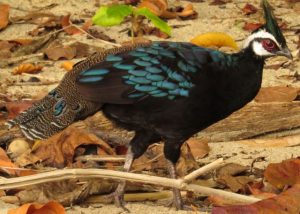 Libby Lyons is a long-time Arlington resident who had the chance to live in Japan in 2016. She explored that amazing country with a focus on fauna, flora, fabric and food. She birded from Hokkaido with its Steller’s Sea Eagles and Japanese Cranes to Kyushu with the sunrise spectacle of an eddy of 10,000 cranes, and to Okinawa viewing the elusive Okinawa Rail. She also took birding forays (often in conjunction with work trips) to Thailand, the Philippines, and Taiwan.
Libby Lyons is a long-time Arlington resident who had the chance to live in Japan in 2016. She explored that amazing country with a focus on fauna, flora, fabric and food. She birded from Hokkaido with its Steller’s Sea Eagles and Japanese Cranes to Kyushu with the sunrise spectacle of an eddy of 10,000 cranes, and to Okinawa viewing the elusive Okinawa Rail. She also took birding forays (often in conjunction with work trips) to Thailand, the Philippines, and Taiwan.
Libby was a biology professor for ten years before she joined the National Science Foundation 20 years ago. She will present a travelogue peppered with scientific tidbits, e.g., the decline of such rare species as the Spoon-billed Sandpiper, the syntax of Japanese Tits and conservation attitudes in East Asia.
MEETING PLACE: St. Andrews Episcopal Church, 4000 Lorcom Lane, Arlington, VA.
Our general meetings are open to members of NVABC and the general public and are held at St. Andrews Episcopal Church, 4000 Lorcom Lane, Arlington VA.
It is at the intersection of Lorcom Lane and Military Rd. From the intersection of Spout Run Pkwy and Lorcom Lane go about a half mile on Lorcom to the second traffic light. Turn left onto Military Rd and enter the first driveway on the right. There is parking at the back entrance of the Church and a bigger lot up the driveway. On-street parking is also available. Enter by the back door facing Military Rd leading to the Undercroft where our meetings are held. Our meetings start at 8:00 and there is a meet and greet social for early arrivals from 7:30. For a map of the location, please click <HERE>.
A Million Penguins Watching Penguins in the Antarctic.
Speaker William Young
In 2016, Bill Young 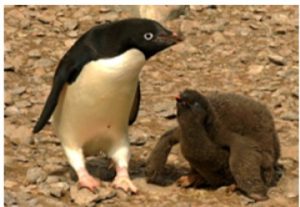 took a cruise from southern Argentina to the Falklands, South Georgia, and the Antarctic Peninsula. On the trip, he saw an estimated one million penguins from seven species. His presentation will focus on each of the species, with special emphasis on their biology and behavior and on the environmental issues affecting them. Penguins are found as far north as the Galapagos Islands, but to see large numbers of them, you need to travel to more southerly waters. Bill is a writer from Arlington and has traveled to all seven continents to observe birds and wildlife. In 2014, his book The Fascination of Birds: From the Albatross to the Yellowthroat was published by Dover Publications. The book contains 99 essays which look at the realtionship between birds and a broad range of subjects, including biology, ecology, literature, music, history, linguistics, politics, sports, entertainment, and other areas. His natural history videos on his YouTube channel have had tens of thousands of views. Last year, he was honored by having a species of snail-killing fly named after him — Dictya youngi.
took a cruise from southern Argentina to the Falklands, South Georgia, and the Antarctic Peninsula. On the trip, he saw an estimated one million penguins from seven species. His presentation will focus on each of the species, with special emphasis on their biology and behavior and on the environmental issues affecting them. Penguins are found as far north as the Galapagos Islands, but to see large numbers of them, you need to travel to more southerly waters. Bill is a writer from Arlington and has traveled to all seven continents to observe birds and wildlife. In 2014, his book The Fascination of Birds: From the Albatross to the Yellowthroat was published by Dover Publications. The book contains 99 essays which look at the realtionship between birds and a broad range of subjects, including biology, ecology, literature, music, history, linguistics, politics, sports, entertainment, and other areas. His natural history videos on his YouTube channel have had tens of thousands of views. Last year, he was honored by having a species of snail-killing fly named after him — Dictya youngi.
What do Birds Eat – Examining bird-insect food webs to improve avian conservation efforts
by
Ashley Kennedy
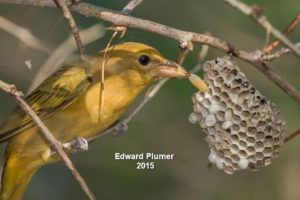 Although insects serve as a vital food source for most terrestrial bird species, particularly while breeding, we still don’t know much about which insects birds prefer as prey. To address this, Doug Tallamy’s lab at the University of Delaware has launched a citizen science project inviting birders across the country to contribute photos of birds with insects in their bills. A better understanding of avian food webs will help us better manage landscapes for avian conservation. Join Ashley as she provides some insight into this important component of bird conservation.
Although insects serve as a vital food source for most terrestrial bird species, particularly while breeding, we still don’t know much about which insects birds prefer as prey. To address this, Doug Tallamy’s lab at the University of Delaware has launched a citizen science project inviting birders across the country to contribute photos of birds with insects in their bills. A better understanding of avian food webs will help us better manage landscapes for avian conservation. Join Ashley as she provides some insight into this important component of bird conservation.
Every good birder knows that birds eat fruits, nuts, and insects, but many people underestimate the importance of the latter. Even birds that are described as primarily frugivorous, g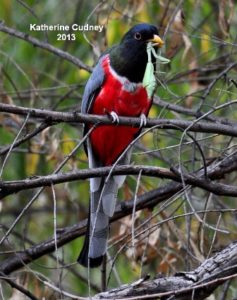 ranivorous, or nectarivorous rely on insects during the breeding season and will dramatically change their foraging patterns during that time to take advantage of the varied proteins, fats, and nutrients insects provide. Field guides and other references, however, rarely provide details as to which kinds of insects are the most important in birds’ diets.
ranivorous, or nectarivorous rely on insects during the breeding season and will dramatically change their foraging patterns during that time to take advantage of the varied proteins, fats, and nutrients insects provide. Field guides and other references, however, rarely provide details as to which kinds of insects are the most important in birds’ diets.
Most studies to date only provide order-level identification of prey (e.g., “beetles”, “caterpillars”), but this broad categorization implies that all beetles or all caterpillars are equally  important to birds. Would a chickadee rather eat a smooth, green inchworm, or a toxic monarch caterpillar— or a densely hairy “woolly bear”? Intuitively, we might guess the inchworm would be the preferred choice, but until we have the data to back it up, this is just speculation.
important to birds. Would a chickadee rather eat a smooth, green inchworm, or a toxic monarch caterpillar— or a densely hairy “woolly bear”? Intuitively, we might guess the inchworm would be the preferred choice, but until we have the data to back it up, this is just speculation.
Ultimately, the lab hopes to be able to answer questions like “Do house wrens in Montana prefer the same types of insects as house wrens in Pennsylvania?” or “Do eastern bluebirds feed their second brood the same insects as the first?” Currently they have about 3,000 photos of a desired 10,000-plus.
Ashley Kennedy is a PhD student in the Department of Entomology and Wildlife Ecology at the University of Delaware. She is also a Northern Virginia native whose interest in birds and insects began right here! Along with her advisor Doug Tallamy, she is investigating birds’ dietary choices and hopes that a better understanding of “what birds eat” will help guide future bird conservation efforts.
WEDNESDAY, NOVEMBER 16, 8 p.m.
Taiwan: Birds, Culture and More…..
Join club members Diane Marton and Joanna Taylor on their journey this past April around Taiwan and its offshore island Lanyu. They were on a Tropical Birding tour led by guide and photographer Charley Hesse.
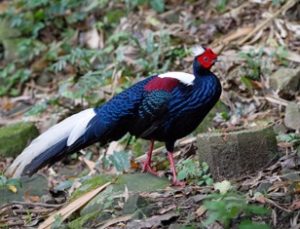
Swinhoe’s Pheasant by Charley Hesse
Taiwan, an island nation thrust out of the ocean floor along the Pacific “ring of fire’, sports stunningly beautiful mountain peaks and seascapes in its small area. Dubbed Formosa or “beautiful island” by the early Portuguese explorers, it claims a high number of endemic plant and animal species, with birds being no exception. The number is continually rising as endemic subspecies are promoted to full species status.
Early bird refreshments start at 7:30 and will include some Chinese finger foods. Any other contributions of food or beverage will be most gratefully received. There will be a drawing for door prizes. Northern Virginia Bird Club pins will be available for members wishing to buy them ($5 each).
DIRECTIONS : Are listed on Page 5 of the Siskin.
NVBC Meetings are usually held at St. Andrews Episcopal Church, 4000 Lorcom Ln,
Arlington 22207, at the intersection of Lorcom Ln and Military Rd. From the
intersection of Spout Run Pkwy and Lorcom Ln, go about a half mile on
Lorcom to the second traffic light. Turn left onto Military Rd and enter the first
driveway on the right. There is some parking near the Church’s back entrance
and a bigger lot up the driveway. There is on-street parking. Enter at the back door
facing Military Rd which leads to the Undercroft where the meeting is held. VA. begining at 8:00 pm, with a social period for early arrivals beginning at 7:30. For a map of the location, click <HERE>.
WEDNESDAY, SEPTEMBER 7, AT 8:00 PM
Why and How DDT was banned, 1972; The Role of Patuxent and the Benefits that Followed by Dr. Charles Wurster
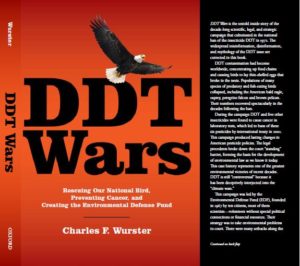 Everybody knows that DDT was banned long ago, but few know the long-term results. In some ways the ban was just the beginning. DDT contamination had become worldwide, concentrating up food chains and causing birds to lay thin-shelled eggs that broke in the nests. Critically important experiments proved the direct connection between DDT and eggshell thinning. There are now 25 times as many Bald Eagles in the lower 48 as there were in 1970, and the data are similar for Ospreys, Peregrine Falcons, Brown Pelicans, Cooper’s Hawks and others. There is no greater victory for birds in the past half century, but it is not generally recognized because it came so gradually over the past 40 years. There were few headlines, and often the credit for the eagle recovery has been attributed in the media to Rachel Carson, “Congress”, legislation, and the Endangered Species Act. All false. The ban made it possible. It’s a great story that Dr. Wurster only came to appreciate as he researched his book DDT Wars: Rescuing our National Bird, Preventing Cancer and Creating the Environmental Defense Fund, written because it seemed to be getting lost to history. There are also many other benefits that came from the DDT ban, which he outlined in his presentation.
Everybody knows that DDT was banned long ago, but few know the long-term results. In some ways the ban was just the beginning. DDT contamination had become worldwide, concentrating up food chains and causing birds to lay thin-shelled eggs that broke in the nests. Critically important experiments proved the direct connection between DDT and eggshell thinning. There are now 25 times as many Bald Eagles in the lower 48 as there were in 1970, and the data are similar for Ospreys, Peregrine Falcons, Brown Pelicans, Cooper’s Hawks and others. There is no greater victory for birds in the past half century, but it is not generally recognized because it came so gradually over the past 40 years. There were few headlines, and often the credit for the eagle recovery has been attributed in the media to Rachel Carson, “Congress”, legislation, and the Endangered Species Act. All false. The ban made it possible. It’s a great story that Dr. Wurster only came to appreciate as he researched his book DDT Wars: Rescuing our National Bird, Preventing Cancer and Creating the Environmental Defense Fund, written because it seemed to be getting lost to history. There are also many other benefits that came from the DDT ban, which he outlined in his presentation.
Dr. Charles Wurster was born and raised in Philadelphia, went to Haverford College,University of Delaware, and received a PhD in chemistry from Stanford University (1957). 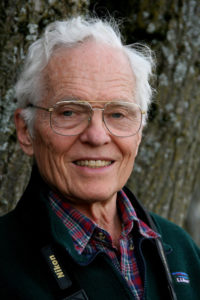 He is a lifelong birder, which got him interested in DDT. Beginning in 1963 he helped organize the scientific case against DDT, and in 1967 became one of the founders of the Environmental Defense Fund, EDF. He remains on the Board of Trustees today. For 35 years he was on the faculty (environmental sciences) at the State University of New York at Stony Brook.
He is a lifelong birder, which got him interested in DDT. Beginning in 1963 he helped organize the scientific case against DDT, and in 1967 became one of the founders of the Environmental Defense Fund, EDF. He remains on the Board of Trustees today. For 35 years he was on the faculty (environmental sciences) at the State University of New York at Stony Brook.
Our meetings begin at 8:00 pm, with a social period for early bird arrivals starting at 7:30. Any contributions of food or beverage will be most gratefully received. There will be a drawing for door prizes. Northern Virginia Bird Club pins will be available for members who would like to buy them ($5 each).

